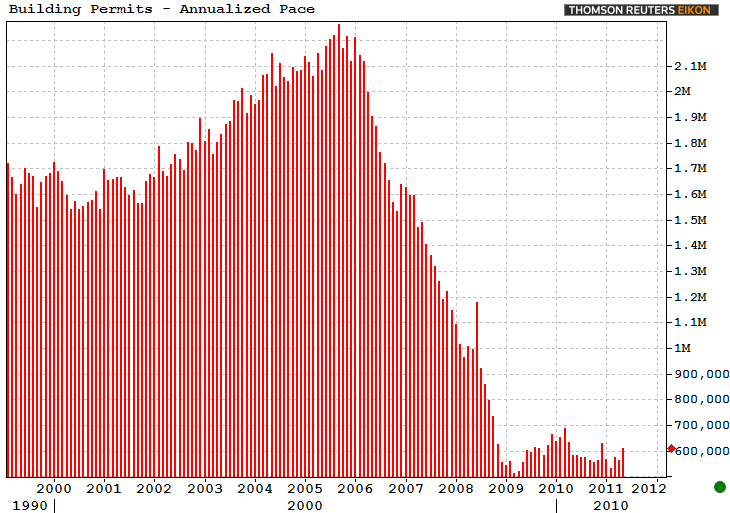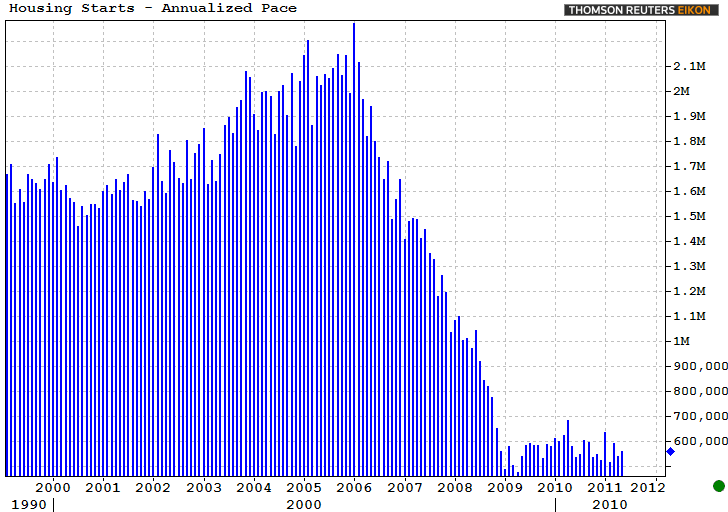The U.S. Census Bureau and the Department of Housing and Urban Development
have released New Residential Construction statistics for May 2011.
Housing Starts data estimates how much new residential real estate construction
occurred in the previous month. New construction means digging has begun.
Adding rooms or renovating old ones does not count, the builder must be
constructing a new home (can be on old foundation if re-building). Although the
report offers up single family housing, 2-4 unit housing, and 5-unit and above
housing data, single family housing is by far the most important as it accounts
for 70-80% of total home building (which should be shifting more toward
multi-family in the years ahead).
Building Permits data provides an estimate on the number of homes planning on
being built. This indicator basically tracks how much future construction
activity we should expect to take place in the future. This data is a part of
Conference Board's Index of Leading Economic Indicators.
Reuters Quick Recap....
RTRS - US MAY HOUSING STARTS +3.5 PCT VS APRIL -8.8 PCT (PREV -10.6 PCT)
RTRS - US MAY HOUSING STARTS 560,000 UNIT RATE (CONSENSUS 540,000) VS APRIL 541,000 (PREV 523,000)
RTRS - US MAY HOUSING PERMITS +8.7 PCT VS APRIL -1.9 PCT (PREV -1.9 PCT)
RTRS - US MAY HOUSING PERMITS 612,000 UNIT RATE (CONSENSUS 558,000) VS APRIL 563,000 (PREV 563,000)
RTRS - US MAY SINGLE-FAMILY STARTS +3.7 PCT TO 419,000 UNIT RATE; MULTIFAMILY +2.9 PCT TO 141,000 UNIT RATE
RTRS - US MAY HOUSING PERMITS RATE HIGHEST SINCE DEC 2010 (630,000 UNITS)
Excerpts from the Release....
BUILDING PERMITS
Privately-owned
housing units authorized by building permits in May were at a seasonally
adjusted annual rate of 612,000. This is 8.7 percent (±1.5%) above the revised
April rate of 563,000 and is 5.2 percent (±2.4%) above the May 2010 estimate of
582,000.
Single-family authorizations in May were at a rate of 405,000; this is 2.5 percent (±1.1%) above the revised April figure of 395,000. Authorizations of units in buildings with five units or more were at a rate of 190,000 in May.

HOUSING STARTS
Privately-owned
housing starts in May were at a seasonally adjusted annual rate of 560,000.
This is 3.5 percent (±12.4%)* above the 12.4%) revised April estimate of
541,000, but is 3.4 percent (±8.7%)* below the May 2010 rate of 580,000.
Single-family housing starts in May were at a rate of 419,000; this is 3.7 percent (±9.5%)* above the revised April figure of 404,000. The May rate for units in buildings with five units or more was 134,000.

HOUSING COMPLETIONS
Privately-owned
housing completions in May were at a seasonally adjusted annual rate of
544,000. This is 0.4 percent (±14.6%)* above the revised April estimate of
542,000, but is 22.5 percent (±9.2%) below the May 2010 rate of 702,000.
Single-family housing completions in May were at a rate of 431,000; this is 2.9 percent (±17.0%)* above the revised April rate of 419,000. The May rate for units in buildings with five units or more was 108,000.
Because the New Home Sales survey is primarily based on a sample of houses selected from Building Permits data, we are able make a forward looking observation about May New Home Sales using today's permit numbers. Building Permits were up 5.2% in May, so New Home Sales should also increase in May following a 7.3% increase in April (but with a 16.6% margin of error). Discrepancies between Building Permits data and the New Home Sales report that follows can be attributed to this statistical margin of error. READ MORE
These month over month improvements seem great, but the new construction market is really just bouncing along near record low levels of activity. National Association of Home Builders Chairman Bob Nielson recently summed up the environment when he said, "Builders are being squeezed by the continuing weakness in existing-home prices - against which they must compete -- as well as rising material costs...In addition to the ongoing impacts of distressed property sales on home prices, appraisal values and consumer confidence, rising costs for materials such as roofing, copper, wallboard, vinyl siding and other components have made it extremely difficult to construct a new home and sell it at a price that covers the costs."







